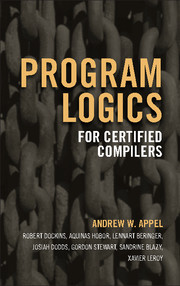Book contents
- Frontmatter
- Dedication
- Contents
- Road map
- Acknowledgments
- 1 Introduction
- I Generic separation logic
- II Higher order separation logic
- III Separation logic for CompCert
- IV Operational semantics of CompCert
- V Higher-order semantic models
- VI Semantic model and soundness of Verifiable C
- VII Applications
- Bibliography
- Index
VI - Semantic model and soundness of Verifiable C
Published online by Cambridge University Press: 05 August 2014
- Frontmatter
- Dedication
- Contents
- Road map
- Acknowledgments
- 1 Introduction
- I Generic separation logic
- II Higher order separation logic
- III Separation logic for CompCert
- IV Operational semantics of CompCert
- V Higher-order semantic models
- VI Semantic model and soundness of Verifiable C
- VII Applications
- Bibliography
- Index
Summary
Synopsis: To prove soundness of the Verifiable C separation logic, we first give a model of mpred as pred(rmap), that is, predicates on resource maps. We give a model for permission-shares using trees of booleans. We augment the C light operational semantics with juicy memories that keep track of resources as well as “dry” values. We give a semantic model of the Hoare judgment, using the continuation-passing notion of “guards.” We use this semantic model to prove all the Hoare rules. Our model and proofs have a modular structure, so that they can be ported to other programming languages (especially in the CompCert family).
- Type
- Chapter
- Information
- Program Logics for Certified Compilers , pp. 362Publisher: Cambridge University PressPrint publication year: 2014

